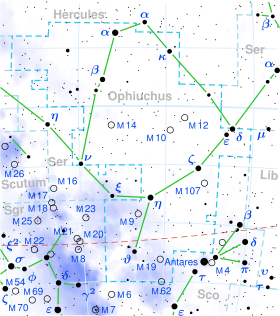
| |
| Observation data Epoch J2000 Equinox J2000 | |
|---|---|
| Constellation | Ophiuchus |
| Right ascension | 17 26 22.21749 |
| Declination | −24° 10′ 31.1190″ |
| Apparent magnitude (V) | 4.16 |
| Characteristics | |
| Spectral type | kA5hA9mF1III |
| U−B color index | +0.12 |
| B−V color index | +0.28 |
| Astrometry | |
| Radial velocity (Rv) | −37.20 km/s |
| Proper motion (μ) | RA: +0.10 mas/yr Dec.: −118.18 mas/yr |
| Parallax (π) | 39.22 ± 0.24 mas |
| Distance | 83.2 ± 0.5 ly (25.5 ± 0.2 pc) |
| Absolute magnitude (MV) | 2.13 |
| Details | |
| Mass | 1.77 M☉ |
| Radius | 1.9 R☉ |
| Luminosity | 13 L☉ |
| Surface gravity (log g) | 4.15 cgs |
| Temperature | 7,559 K |
| Metallicity | +0.30 dex |
| Rotational velocity (v sin i) | 78 km/s |
| Age | 1.028 Gyr |
| Other designations | |
| b Oph, 44 Oph, CD−24°13337, FK5 1457, GC 23597, GJ 9591, HD 157792, HIP 85340, HR 6486, SAO 185401 | |
| Database references | |
| SIMBAD | data |
44 Ophiuchi is a single star in the constellation Ophiuchus. It has the Bayer designation b Ophiuchi, while 44 Ophiuchi is the Flamsteed designation. It is visible to the naked eye as a faint, white-hued star with an apparent visual magnitude of 4.16. The distance to this object is approximately 83.2 light years based on parallax. It is drifting closer to the Earth with a heliocentric radial velocity of -37.2 km/s, and is predicted to come within 30 light-years around 585,000 years from now.
This is an Am star with a stellar classification of kA5hA9mF1III, indicating it has the luminosity class of a giant star with a spectrum that matches an A5 star based on the calcium K line, and an A9 star from the hydrogen and metal lines. It is around a billion years old with 1.77 times the mass of the Sun and 1.9 times the Sun's girth. The star is radiating 13 times the Sun's luminosity from its photosphere at an effective temperature of 7,559 K. It retains a moderately high rotation rate, showing a projected rotational velocity of 78 km/s.
References
- ^ Van Leeuwen, F. (2007). "Validation of the new Hipparcos reduction". Astronomy and Astrophysics. 474 (2): 653–664. arXiv:0708.1752. Bibcode:2007A&A...474..653V. doi:10.1051/0004-6361:20078357. S2CID 18759600. Vizier catalog entry
- ^ Anderson, E.; Francis, Ch. (2012). "XHIP: An extended hipparcos compilation". Astronomy Letters. 38 (5): 331. arXiv:1108.4971. Bibcode:2012AstL...38..331A. doi:10.1134/S1063773712050015. S2CID 119257644. Vizier catalog entry
- ^ Gray, R. O.; Corbally, C. J.; Garrison, R. F.; McFadden, M. T.; Bubar, E. J.; McGahee, C. E.; O'Donoghue, A. A.; Knox, E. R. (2006). "Contributions to the Nearby Stars (NStars) Project: Spectroscopy of Stars Earlier than M0 within 40 pc--The Southern Sample". The Astronomical Journal. 132 (1): 161–170. arXiv:astro-ph/0603770. Bibcode:2006AJ....132..161G. doi:10.1086/504637. S2CID 119476992.
- ^ Mallama, A. (2014). "Sloan Magnitudes for the Brightest Stars". The Journal of the American Association of Variable Star Observers. 42 (2): 443. Bibcode:2014JAVSO..42..443M.Vizier catalog entry
- ^ Gontcharov, G. A. (2006). "Pulkovo Compilation of Radial Velocities for 35 495 Hipparcos stars in a common system". Astronomy Letters. 32 (11): 759–771. arXiv:1606.08053. Bibcode:2006AstL...32..759G. doi:10.1134/S1063773706110065. S2CID 119231169.
- ^ Zorec, J.; Royer, F. (2012). "Rotational velocities of A-type stars". Astronomy & Astrophysics. 537: A120. arXiv:1201.2052. Bibcode:2012A&A...537A.120Z. doi:10.1051/0004-6361/201117691. S2CID 55586789. Vizier catalog entry
- ^ Allende Prieto, C.; Lambert, D. L. (1999). "Fundamental parameters of nearby stars from the comparison with evolutionary calculations: Masses, radii and effective temperatures". Astronomy and Astrophysics. 352: 555–562. arXiv:astro-ph/9911002. Bibcode:1999A&A...352..555A. Vizier catalog entry
- ^ David, Trevor J.; Hillenbrand, Lynne A. (2015). "The Ages of Early-Type Stars: Strömgren Photometric Methods Calibrated, Validated, Tested, and Applied to Hosts and Prospective Hosts of Directly Imaged Exoplanets". The Astrophysical Journal. 804 (2): 146. arXiv:1501.03154. Bibcode:2015ApJ...804..146D. doi:10.1088/0004-637X/804/2/146. S2CID 33401607. Vizier catalog entry
- "b Oph". SIMBAD. Centre de données astronomiques de Strasbourg. Retrieved 2019-06-21.
- Eggleton, P. P.; Tokovinin, A. A. (September 2008). "A catalogue of multiplicity among bright stellar systems". Monthly Notices of the Royal Astronomical Society. 389 (2): 869–879. arXiv:0806.2878. Bibcode:2008MNRAS.389..869E. doi:10.1111/j.1365-2966.2008.13596.x. S2CID 14878976.
- Bailer-Jones, C. A. L. (March 2015). "Close encounters of the stellar kind". Astronomy & Astrophysics. 575: 13. arXiv:1412.3648. Bibcode:2015A&A...575A..35B. doi:10.1051/0004-6361/201425221. S2CID 59039482. A35.